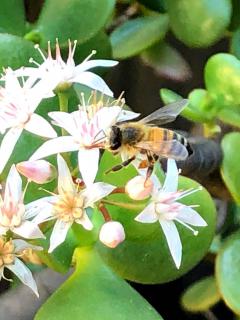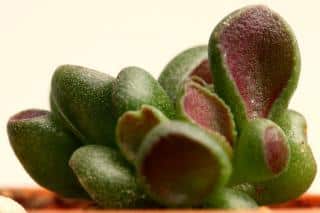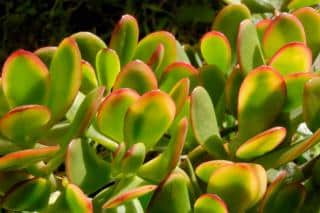

The jade plant is a succulent that offers magnificent evergreen leafage.
Key Jade Plant facts
Name – Crassula ovata
Family – Crassulaceae
Type – bonsai, succulent plant
Height – 1 ½ feet (50 cm)
Exposure – well-lit
Soil – light, well-drained
Foliage – evergreen – Flowering – summer
Caring for it is something anyone can succeed in, even though to keep it beautiful these tips will be very useful.
The jade plant is native to South Africa and adapts well to mild climates.
It is preferable to grow your jade plant indoors if you expect freezing over the winter. Indeed, the slightest frost would kill it.
 You may repot your jade plant just after having purchased it if you’ve purchased it when not in flower, but pots for this plant are usually designed for another two good years of use before growing too small for the plant.
You may repot your jade plant just after having purchased it if you’ve purchased it when not in flower, but pots for this plant are usually designed for another two good years of use before growing too small for the plant.Jade plants can be propagated by preparing cuttings from young stems.
It is usually quite easy to get the jade plant to sprout roots.

Jade plant flowers in summer, and its flowers are great for pollinating insects like bees. However, it’s a pretty rare occurrence and the jade tree must feel very much at home before blooming!
To grow a jade plant as a bonsai, a few pruning tips are applicable:
The jade plant can grow to be quite dense, so its root system must be well developed to counter the weight of its leaves and branches.
If you restrict the watering, you’ll force the roots to delve deeper for moisture, thus making them grow.
In any case, it is important to wait for the soil to have dried well before watering, in which case it is also better to water once rarely with a significant amount instead of many moderate sessions.
Leaves from succulents are loaded with water. If they start collapsing, it shows that they need more water.
The jade plant resists most diseases and parasites very well, normally you won’t need to treat it.
You might occasionally encounter scale insects (also called mealybugs), but they’re easy to get rid of.
However, its main enemy is rot due to excess watering.


With its reduced need for care, it poses practically no difficulty to the caretaker and is easily trimmed to a bonsai shape.
Although excess water is what most often kills it, it also likes having alot of light, but not scorching direct sun, as when behind a window.
You can set it in a pot or a garden box, along edges or on rocky ground.
Collect fallen or broken leaves and arrange them on cactus potting mix. Ensure moisture by spraying or misting from time to time and you’ll see new jade tree seedlings sprout!
thanks for the information
You’re welcome!